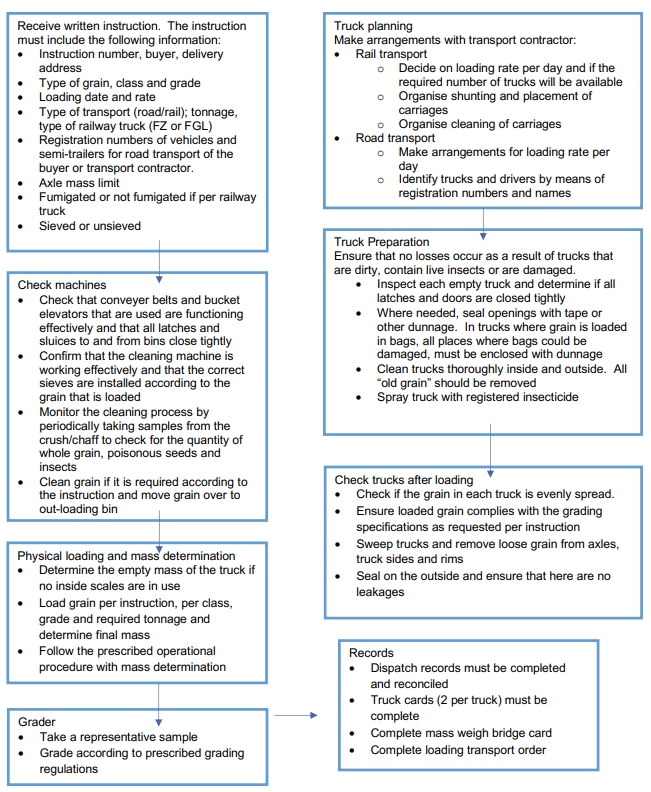Mistakes in connection with dispatching (grade, mass, etc.) could have serious financial consequences for the silo. The following steps must be followed when grain is dispatched:
Preparation Before Disposal
As in the case of grain reception, all the necessary preparation must be done to make available the necessary personnel and equipment.
Produce Inspection
Grain samples are drawn from storage bins and analysed to ensure the product matches the specific requirements of the order.
Grain is moved from designated bins to the cleaner and to the bagging bins in the warehouse. Samples of grain are taken and analysed for quality. Grading sheet is prepared and details entered in the register.
Loading
The buyer presents documents authorising collection of grain to silo manager who authorises loading.
- The truck is allowed to weigh. It is important that correct weight of goods is established. Gross weight and tare weights must be carefully taken and the net weight of product computed. The weighbridge clerk raises weighbridge ticket and updates the register.
- At the warehouse, the truck is loaded with the authorised quantity of bags of the commodity. The store clerk raises the Store Issue Voucher and lorry is allowed to proceed to weighbridge for final weighing and documentation.
- After loading, all spillages is swept, reclaimed and bagged.
Grain Shipment Process Map (AGBIZ)

Off-loading at a Bunker
Bunkers need to be inspected prior to outturn to detect any holes, contamination, gas reading or anything that may hinder outturn. Look for insects (on the sunny side) If ANY gas concentration is found, contact your supervisor immediately and stop all operations.
During the off-loading tarps are required to be pulled back up the heap to expose the grain mass. Remove clamps and steel box sections equally from each side of the bunker. Place employees evenly across the trap face, secure tarp pullers and pull the tarp up the face in order to expose the grain.
Once the equipment is set up and the bunker is free of any contamination, it is time to start out loading. Front-end loaders have limited access to the grain mass in these early stages of outturn, both drivers and employees must be aware of the risks involved here.
The front-end loaders will work the face of the heap, dumping the grain into the hopper. It is important to always keep the front of the grain mass square and even, this will aid drainage and sealing when the tarp is pulled down to cover the grain mass.
Once enough room has been made in the bunker, position the Stacker within the walls. Be sure to use the Stacker frequently so the front-end loaders do not have to travel too far. At the end of the day’s out-loading, the tarp is pulled back down the heap and the steel box sections and clamps are replaced to secure it.
Weights are also placed across the face of the heap to prevent the tarp from moving. It is recommended to pull any excess plastic or ground cover back up the heap a little way, then pull the main tarp cover down, as this will prevent any water ingress and/or contamination.
Once the weights are across the face of the heap, the bunker straps can be placed across the top of the tarp and also halfway down from the peak, if necessary. This will also help secure the tarp into place.
All grain must be out turned from a bunker in such a way to minimize losses and maximise quality. The front-end loader's bucket should be set at a level to minimise losses and maximise quality. If the front-end loader scrapes a hole in the plastic, then that grain around the hole must be sampled/screened to identify weather any contamination has been caused by stones and dirt. If contamination does result, the grain must be segregated into the appropriate miniature bunker. The manager must be notified of this occurrence.
Click here to view a video that demonstrates the offloading of a bunker.